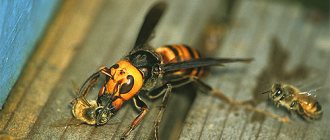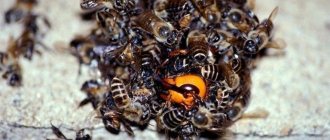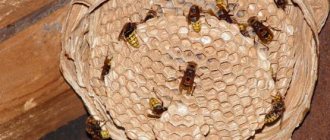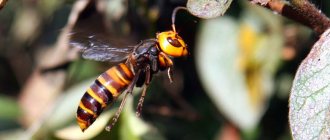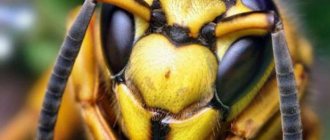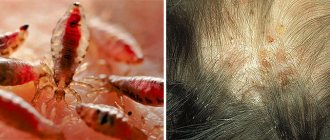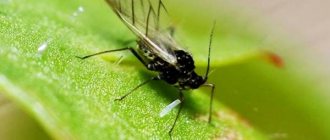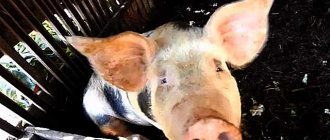Hornets are large wasps that, by their mere appearance, cause fear and an inexplicable feeling of anxiety in most people. It is not surprising, because these insects are predators and amaze with their size - the common hornet reaches 3-3.5 cm, some species - 6 cm in length. In addition, hornet stings are very dangerous to human health - they release twice as much poison in one bite as bees. Since the sting of insects is long and without serrations, they can sting more than once, but until the poison runs out.
Despite these characteristics, it should be understood that hornets are very beneficial insects for the environment. The fact is that adult individuals mainly feed on plant foods: berries, fruits, nectar. Their larvae are fed minced meat from caterpillars, flies, mosquitoes, beetles, spiders and other insects. In just one day, a family of hornets catches almost half a kilogram of pests - this is a fairly significant role in the ecosystem cycle.
Hornets nest
Hornets are rarely aggressive, they do not attack without reason, they are not as annoying as ordinary wasps, and they try to stay away from people. The reason for the attack is most often a threat to the nest or the insect itself.
Important! You should not unreasonably destroy hornet hives - many species of these insects are already at the stage of extinction, some are listed in the Red Book. It is necessary to get rid of hornets only in cases where they pose a danger to human health and quality of life.
What does a hornets nest look like?
Hornets are real architects; their hives amaze with their thoughtfulness, accuracy, and practicality. The shape of a hornet's nest resembles a ball or cone. Its average dimensions are: 30-50 cm – width and 50-70 cm – length. Under optimal conditions, much larger structures can be found - more than a meter. Moreover, the weight of an empty hive rarely exceeds 1 kg.
In its structure, the nest resembles a multi-story building with many rooms and several entrances. In this case, the rooms are honeycombs, the entrances are compartments. The compartments are formed around an axis and separated by a thin partition. Perpendicular to the axis there are floors - tiers along which the uterus moves. They are fastened together by several legs.
One dwelling consists of 3-4 compartments and 7-10 tiers, the whole structure is neat, airy, and can look very impressive.
How is the nest constructed?
The shape of the shelter can be different, it all depends on the site on which it is built. Initially, the nest resembles a pear or ball. However, as the colony grows in size, the configuration changes greatly. In some cases the original form is preserved, in others it is greatly expanded. The average dimensions of a hornet shelter are: width about 40 cm, height – 70 cm.
Inside there are many cells, chambers, passages and even floors. For construction, insects use the thin bark of young plantings. It is chewed and then mixed with saliva.
It resembles a large fruit, the width of which can reach 40 cm and the height - 70 cm. The design is light gray.
This produces a fairly plastic material with which the cells of the nest are built. In autumn it empties naturally. This happens because some of the hornets go in search of warmer shelter during the wintering period, the remaining majority die.
The nest has separate floors; they are connected to each other by very strong pendants.
How to find a hornets nest
Hornets are, at their core, beneficial insects. They do not harm people if left alone. If a hornet hive is found in natural conditions or outside the human habitation area, you should not destroy it or destroy it. In this case, insects are part of the natural environment and fulfill an important role assigned to them.
How to find a nest
How to destroy a hornet nest
As for the hornet family settling near people, you should be careful - this is a rather dangerous neighborhood. Especially if the insects have built a nest in a frequently used or visited place.
The proximity of these giant wasps can be deadly for bees - the hornets attack apiaries, destroy adults and larvae, and eat honey. If even small groups of insect predators regularly appear on a summer cottage or garden plot, it is necessary to start searching for a nest.
Advice. It is very important to start searching and discover the hive in the initial stages of its formation. The queen lays the foundation of the nest - it is she who lays the first tier and lays eggs in the honeycomb. During this period, you can quite easily remove it from the site or destroy it. After a few weeks, the number of young individuals will rapidly increase, and it will be more difficult to get rid of the hive.
Hornets prefer quiet, secluded places, protected from bad weather - this could be a hollow in a tree, a hole in the ground, abandoned buildings, barns, attics.
The search for a nest can be organized as follows:
- Make preparations. An encounter with hornets is quite dangerous for humans. It is very important to prepare properly for it: stock up on antiallergic drugs, wear closed, made of thick material or special protective clothing.
- Start inspecting the premises. Attics, basements, sheds, and outbuildings are carefully examined. Nests are often found in window frames, under the floor and even in the wall. This arrangement is dangerous; it will be very difficult to remove the hornets.
- Conduct an inspection of the entire area. The garden, trees, fallen logs, and stumps are examined. You can take a closer look at the holes in the ground, in particular, under trees.
- Listen. If a visual inspection does not bring results, you can try to hear the hornets - they are quite noisy, especially during the period of nest construction.
- Label the insect. An interesting method that can be used if the search does not produce results. To do this, you need to catch the hornet and mark it with a bright thread or ribbon. Then you can release the insect and carefully monitor the direction of its flight.
Interesting. Contrary to popular belief, hornets do not sleep at night - they are simply less active, but are ready to defend their home.
Having discovered a hornet nest, the degree of danger that insects can bring is determined, depending on their habitat. If the hive is located in a corner where hornets and people do not intersect, it is better not to touch it and let the wasps exist in peace.
If the home is located in a frequently visited place, you will have to get rid of it. This process is quite complex and dangerous, since hornets are always active and aggressive in defense.
The most effective methods for destroying a hive:
- Treat with insecticides.
- Drown.
- Burn.
- Pour boiling water over it.
These methods are tough and quite risky, so it is better to resort to them only in extreme cases.
Methods for destroying nests
Methods for destroying nests
The use of nests in such insects is seasonal and occurs only in the spring-summer-autumn period. Then the hornets leave their nests: most die, and the fertilized females hide in secluded places in hollows or under the bark of trees, where, as the weather gets colder, they enter diapause until spring.
On a note!
Winter is the ideal time to destroy an already empty hive. It is easy to remove and destroy without fear of being bitten.
It is much more difficult to remove a nest along with its inhabitants, because they guard their home very vigilantly and can attack a person, causing him a lot of harm.
Therefore, you should definitely consider and take all possible protective measures:
- wear clothes made of thick fabric with long sleeves, the cuffs should fit close to the arms and fasten;
- Be sure to wear a thick hat on your head, or better yet, a protective helmet with a mesh;
- on feet - boots and gloves - on hands;
- safety glasses or mask - on the face;
- in such a situation, a beekeeper suit is ideal;
- prepare a disinfectant in case of bites, as well as an anti-allergenic agent;
- think over in advance a “retreat plan” and escape if a swarm of hornets chases you: a pond or an enclosed space;
- children or allergy sufferers should be temporarily relocated to another place.
Preparations for destroying hornet nests
There are several ways to destroy a hornet nest. It is better to do this at night or at dusk:
- Drowning the hive in a bucket of water or in a solution with kerosene, and it is not at all necessary to remove it. If the nest is located at the top, then it is better to raise the bucket to it, placing a stepladder under the bottom. Immerse the entire hive in liquid for several hours, preferably for a day. After waiting time, remove the softened house.
- You can remove the nest quite easily by treating it with an insecticidal aerosol designed to destroy pests: Executioner, Get, Karbofos, Lambda Zone, etc. You will need 2-3 bottles. You need to spray the entire internal cavity of the hive through the entrance hole, then go away and not touch it for several days. During this time, those individuals who did not spend the night in it will also return to the poisoned home, and they will also die from the poison. Later, it is better to burn the house.
- Treat the nest with foam from a fire extinguisher, trying to wet the honeycombs, all the inhabitants freeze. Then the house can be torn off from the base and destroyed.
- You can remove a nest hanging on a tree branch by burning it, which will require kerosene or gasoline, but you should be careful not to start a fire.
- If the hornets have settled in a hollow tree that has a narrow entrance, then you can pour a strong chemical into it and then quickly seal all the cracks.
- You can reliably destroy the nest and its inhabitants by taking a large plastic bag and spraying it with a stream of insecticidal spray, then covering or wrapping it around the home, trying to seal it. This method is convenient when you need to remove a hornet nest in your home.
- Another method is to block the entrance to the nest using polyurethane foam.
- When the colony is located in a hole underground, it is better to pour boiling water over it or build a fire in this place, slightly digging up the entrance hole.
- You can pour kerosene into the “underground” dwelling and set it on fire.
On a note!
All of these methods are best used at night or in the evening, when predator activity is reduced. Contrary to popular belief, night is not the time when hornets sleep: at such hours they either rest or are busy with other things. During procedures, you need to use a flashlight very carefully, because insects react negatively to changes in lighting.
How many hornets live in a nest
How to remove hornets from the attic
How many hornets in one nest depends on the comfort of the location of the home and on external factors: weather conditions, availability of food. One family settles into the structure, numbering several hundred adult insects, approximately 400-600 pieces.
Under optimal conditions in a calm, quiet, warm place with large amounts of food, the family becomes strong and produces high-quality offspring in significant numbers. In such cases, the hive reaches a gigantic size - more than a meter in diameter, inhabited by one to two thousand individuals.
Appearance of hornets and the danger of their bites
Hornets are insects that are very similar in appearance to wasps, but have some differences: a larger body size, a brown abdomen. They are useful predators because they feed on various garden pests and their larvae. They also love sweet nectar, vegetable juices of fruits and honey. There are more than 20 species of hornets in the world, many of which are listed in the Red Book.
If large yellow-black wasps often fly into a room, it means that hornets have built their nest nearby.
It is completely optional to kill individual individuals: they cannot be frightened or waved at them. It is better to wait until such a “wasp” lands and catch it by covering it with a glass jar. Then take it away and release it into fresh air.
However, you should be aware that having a colony settled nearby can cause a lot of problems due to their ability to protect their home and numerous bites.
The danger from hornets has several unpleasant aspects:
- when defending their home, they can attack a person and inflict numerous bites on him;
- when stinging, hornets are able to remove the sting and bite their offender several times in a row, which is more dangerous to health, since the toxicity of such poison can lead to a severe allergic reaction;
- such insects harm bees by attacking and killing them and destroying their hives.
For children, pregnant women and people with allergies, numerous hornet stings pose a great danger, as they can cause angioedema, anaphylactic shock and lead to death.
Therefore, in order to get rid of such unpleasant neighbors, you should definitely start looking for hornets in your home, and for this you need to know what the nest looks like and where to look for it.
How hornets build nests
How to get rid of hornets in the country
One can only be amazed at how hornets build their nest - how much work, discipline, and self-organization is invested in this process. Insects make their homes durable and comfortable. It protects them from heat and cold.
An interesting fact is what hornets make their nests from. The materials for construction are wood and bark. Hornets especially like birch, which is why their nests are lighter than those of other wasps. Pieces of wood are thoroughly chewed, moistened with saliva, and honeycombs, walls, partitions, and shells are gradually molded from the resulting material, ball by ball.
The queen chooses the nest site. She begins to build her future home. First, the queen fashions the first ball of cells in which the eggs are laid. After about a week, the eggs turn into larvae, which, in turn, degenerate into pupae in two weeks. After another two weeks, young worker hornets fly out of the nest and continue to build housing.
How productive the work of the new generation of insects will be depends on how many hornets in the nest will develop throughout the season. After the worker hornets fly out, the eggs of future females and males are laid. They fly out already sexually mature, and immediately after their departure swarming begins.
Prevention of hornets and nest building
Preventing the appearance of hornets and building a nest
To prevent hornets from settling in a garden plot or apiary, experienced gardeners and beekeepers begin to carefully monitor the appearance of females in the spring, which, after hibernation, begin to search for a favorable place to form a colony.
Large females up to 5 cm in size, having found a suitable branch or hollow, begin to build a nest in order to breed offspring and organize a colony. At first it looks like a small walnut. At such a moment, you can easily tear it off with a shovel or other tool, then crush it or burn it along with its inhabitants.
Experts also advise making traps in the spring to catch queen hornets, for which you place a bucket of water, to which you add something sweet or sour (vinegar), and then add soap. Insects fly to the smell and then drown due to the inability to get out of the liquid.
Similarly, a trap is made from a plastic bottle with the neck cut off, which is placed inside like a “funnel”. A solution of honey and beer is poured inside, the aroma of which attracts all the insects and falls down. They will no longer be able to get up.
Such methods will help prevent the spring settlement of a hornet colony on a plot or apiary. By the beginning of summer, all the large queens have established their homes, and the danger of their arrival is sharply reduced.
Important!
The hornet cannot simply be killed or slammed, because when crushed, an odorous substance is released from the body, which signals danger to its fellows and calls them to help. And this is fraught with the beginning of a massive attack by an entire colony of “biting” insects.
When the hornets fly away from the nest
By the end of autumn, the hornets' home gradually becomes empty. To figure out when hornets leave their nests, you need to figure out some nuances.
Nest without hornets
Males die almost immediately after swarming. With the onset of cold weather and frost, the working hornets and the queen die. During the same period, fertilized females look for a suitable secluded, warm place for wintering.
With the arrival of autumn, females begin to produce a special substance, which in winter serves as a kind of antifreeze that prevents them from freezing during suspended animation. Trees, hollows, and outbuildings can become temporary homes for hornets. Some individuals may remain over the winter in the old hive.
Only a small percentage of insects survive the cold and thaw. Already with the onset of the first spring warmth, the females leave their shelter and begin to search for a suitable place to found a new hive.
An interesting fact is that hornets do not settle in an old nest - they always build a new house.
Note! Considering the behavior and life cycle of hornets, the optimal periods for removing hives are late autumn and winter. At this time, the nest is empty, there is no risk of insect attack and their return. The nest can be easily removed by sawing off the base and burned.
Hornets are beneficial insects, an indispensable link in the ecosystem. There is no need to thoughtlessly destroy their nests; these insects do not attack without reason. Large wasps become aggressive only when defending themselves and their home. If the hornets begin to build a nest indoors, on the territory of a summer house or personal plot, endangering people's health, you need to try to get rid of it.
3 1 vote
Article rating
Overview of hive destruction methods
The easiest way: the shelter is destroyed in winter, when there are not a single insect inside. However, this option has a significant disadvantage - you will have to endure the presence of pests throughout the spring and summer, waiting for their natural death in the fall. In addition, the queen is unlikely to return to her original place, because she does not live longer than a year, which means that older females will begin to search for a new place for refuge. When deciding how to remove a nest in the warm season, it is recommended to consider the following methods:
Drowning
This option is suitable for cases when the shelter is in a hanging position. It is placed in a bucket. There is no need to remove the nest; you just need to place a container of water of suitable depth directly underneath it. It is important to ensure that the entire structure erected by the hornets is completely immersed in the liquid. It is better to do this at night, since insect activity decreases at this time.
If the nest is in the ground, you can pour boiling water over it. The hornets' home can be large; you will need a bucket of water.
Burning
First, the shelter is doused with a moderate amount of flammable substance (kerosene, gasoline), then set on fire. The method is suitable for situations where the nest is located on a base made of non-flammable material.
Poisoning
Use any toxic insecticide: GET, Executioner, and similar drugs. The substance is sprayed into a plastic bag and wrapped around the hornets' shelter.
Spray some plastic with insecticide (Get, Lambda Zone, Executioner) and wrap it around the nest.
If the nest is built in a depression, for example, a hollow, you can pour insecticide inside. In this case, the entrance must be closed. Shelters located in the ground are doused with boiling water.
Interesting video: Methods for destroying hornet nests
